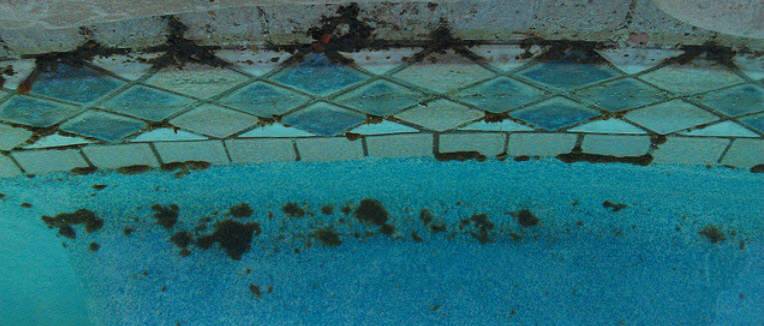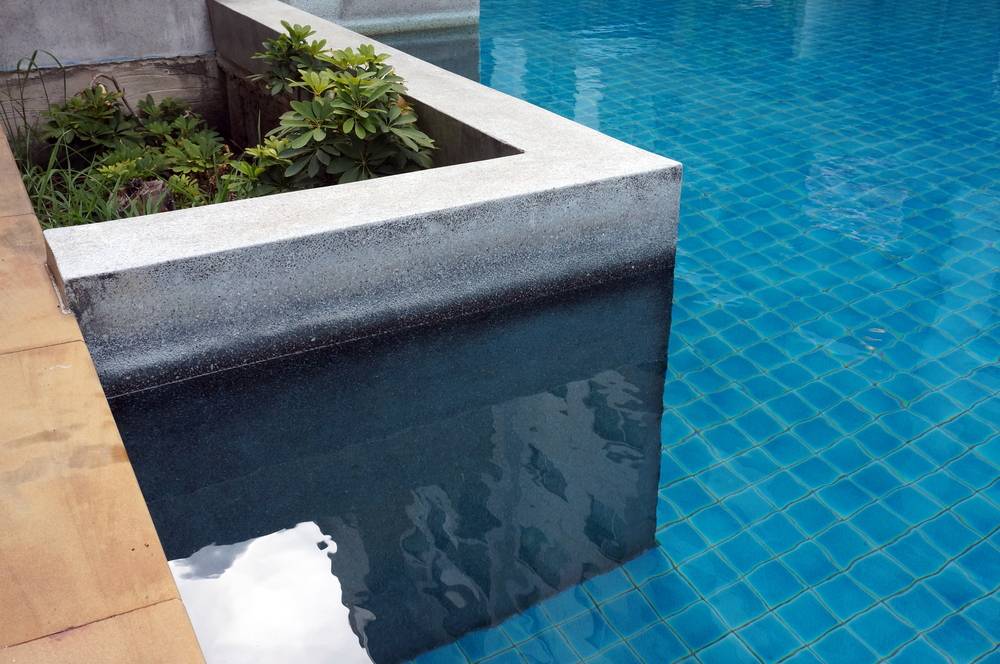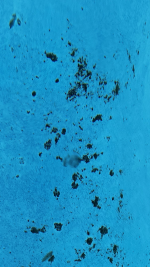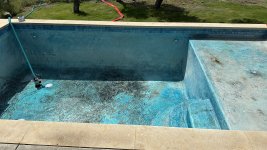Hello all: I purchased this home with an unground pool about a month ago. It had black staining along the walls and floors of the deep end which I now believe to be black algae. The pool is an unground Gunnite Pool. I have done the following: Scrubbed twice daily with a metal brush. Treated with Black Algae killer from Leslies Pools and Black Algae Killer from in the swim active ingredient (copper sulphate pentahydrate 11.8%). SLAM shock chlorination and additional scrubbing. 1.5 gallons of Muriatic Acid followed by additional scrubbing. The areas are lightening and disappearing in places however some has now settled on the floor which is extremely difficult to get at since the pool is about 8-9 foot deep. I did all this in preparation for adding a stain removal kit but am unable to do so due to the high levels of phosphates that are now in the water. I am at my whits end trying to get rid of this stuff. After the last SLAM shock my numbers from Leslies were free chlorine 13.48; total chlorine 13.48 PH 6.8; alkalinity 9; calcium hardness 342; cyanotic acid 85; iron 0; copper .4; phosphates 1965; TDS 500; after adding the chlorine reducer and phosphate reducer six hours later my levels were free chlorine 6.16; total chlorine 6.89; PH 6.8; alkalinity 5; calcium hardness 291; cyanic acid 85; iron .1 copper .2 phosphates 1777; TDS 500. I have added photos below to show where I started and where I am now. The first three are where I started and the last three are where I am now - the staining looks deeper (darker) depending on lighting. I believe the stains are getting better but this is very slow going for an almost 60 year old woman and a two inch scrub brush.
Black Algae Nightmare
- Thread starter makeitrainlawyer
- Start date
You are using an out of date browser. It may not display this or other websites correctly.
You should upgrade or use an alternative browser.
You should upgrade or use an alternative browser.
- Apr 10, 2018
- 6,331
- Pool Size
- 18375
- Surface
- Plaster
- Chlorine
- Salt Water Generator
- SWG Type
- CircuPool RJ-45 Plus
- Apr 10, 2018
- 6,331
- Pool Size
- 18375
- Surface
- Plaster
- Chlorine
- Salt Water Generator
- SWG Type
- CircuPool RJ-45 Plus
To test for black algae, try to scrape a bit of the substance with your fingernail. Wipe it on a paper towel or white piece of paper. If it smears green, its BA.
I have yet to be able to scrape any of it off the sides of the pool. The stains are waxy in feel and are raised from the concrete pool walls.
- Apr 10, 2018
- 6,331
- Pool Size
- 18375
- Surface
- Plaster
- Chlorine
- Salt Water Generator
- SWG Type
- CircuPool RJ-45 Plus
You should be able to scrape BA off the wall. Try a wood/bamboo skewer or something similar.
Take a look at the article below...

 www.troublefreepool.com
If not BA, take a look at the article below. Try the dry acid method in a sock to diagnose copper.
www.troublefreepool.com
If not BA, take a look at the article below. Try the dry acid method in a sock to diagnose copper.
What type of filter do you have. If copper, the filter grids may be bluish colored.
I have not heard copper described as waxy.
If @JamesW or @ajw22 are around, they may be able to provide some guidance.

 www.troublefreepool.com
www.troublefreepool.com
Take a look at the article below...

Black Algae
This guide provides a step by step procedure for eliminating black algae in your concrete or gunite pool. Read full post here.
What type of filter do you have. If copper, the filter grids may be bluish colored.
I have not heard copper described as waxy.
If @JamesW or @ajw22 are around, they may be able to provide some guidance.

Stains in Your Pool
The stained pool is beyond embarrassing. Our in-depth Guide to remove stains in your pool will help you to remove the stains and prevent them in the future.
- Apr 10, 2018
- 6,331
- Pool Size
- 18375
- Surface
- Plaster
- Chlorine
- Salt Water Generator
- SWG Type
- CircuPool RJ-45 Plus
Besides the most recent algaecide you purchased from Leslie's, what other copper products have you used? Any other algaecides, mineral systems, or Pool RX?
This is probably black algae, which can look a lot like black copper stains.
Sometimes you can get black algae and black copper stains, which makes diagnosis more difficult.
Black algae is often treated with copper algaecide, so they can both be a problem at the same time.
In this picture, the turquoise and gray are probably copper and the black is probably black algae.
Black algae tends to grow in pits, whereas copper stains are more widespread with no particular focus points.

Sometimes you can get black algae and black copper stains, which makes diagnosis more difficult.
Black algae is often treated with copper algaecide, so they can both be a problem at the same time.
In this picture, the turquoise and gray are probably copper and the black is probably black algae.
Black algae tends to grow in pits, whereas copper stains are more widespread with no particular focus points.

White stains expanding on gunite pool - Please Help
Hello, My pool was built back in June, 22 by A&S. It came with the house we purchased. It is a gunite pool. I observed white stains a couple months back, and they are expanding. I have a high Ph problem due, not sure because it is a new pool or just swg. I am really note sure if these...
Blue green stains
I have a plaster pool and spa that both were initially the same color. The spa developed a blue green stain. I am in the middle of slamming it because I assumed this was an algae stain. I read more about it and tried both the trichlor pucks test and the vitamin c test. Neither removed or...
Black Algae and High Copper
I used the Copper Ionizer and did not notice copper went high 1.5. Pool wall and bottom is black color now. It looks like black Black Algae. Please advice how to control the Copper or black Algae. I used No Metal from Leslie pool and cleaned the filters, no luck.
Two-Year-Old Pool Major Discoloration and Bleaching
Hi, Everyone! New to the forum and to pools in general. Closed on a house with my first pool! Yay! Although it's only two years old it has major discoloration (light and dark spots). General home inspector thought it was algae but the water is so clear. Here is what the prior owners...
No other copper products used. I tried testing the stains with a tricolor puck and with a vitamin c tablet neither one seemed to move them. Honestly the best I have ever seen them at least budge was after doing the muriatic acid. The filter is a regular Haywood sand filter.Besides the most recent algaecide you purchased from Leslie's, what other copper products have you used? Any other algaecides, mineral systems, or Pool RX?
Most likely, a treatment of Jack's #2 and/or a zero TA treatment will be necessary to remove the stains followed by a drain and refill if it is safe to drain.
Do not drain without making sure that it is safe to do so.
The treatments might not work and it might even cause damage and make things worse.
The processes have big risks and you need to do extensive research before deciding what options are available and what the costs, benefits, risks etc. are.
 jacksmagic.com
jacksmagic.com
Do not drain without making sure that it is safe to do so.
The treatments might not work and it might even cause damage and make things worse.
The processes have big risks and you need to do extensive research before deciding what options are available and what the costs, benefits, risks etc. are.
STAIN SOLUTION #2 – The Copper & Scale Stuff | Jacks Magic
Trying to avoid draining it at all costs - would prefer a stain removal treatment that can be done with the pool full of water.Draining - Further Reading
www.troublefreepool.com
You can probably do the treatments and then do a lot of dilution.
The treatments are very aggressive and not recommended unless it is absolutely necessary.
The surface will be etched and the life of the plaster will be reduced.
The treatments are very aggressive and not recommended unless it is absolutely necessary.
The surface will be etched and the life of the plaster will be reduced.
so if it is just a copper stain and if removing it damages the plaster then why not just leave it until the fall then have a company come out and drain it and replaster the pool?
Also curious as to why phosphate levels jumped from 174 on June 30 to 1965 on July 3? which was after the muriatic acid treatment
Replaster is an option.
It is expensive to replaster.
Have you gotten quotes for a full chipout and replaster?
With the stains, there are no easy answers.
The stains are probably just cosmetic.
Some people won’t care about the appearance and some people will want to trade plaster life for a better cosmetic appearance.
I am just trying to give you enough information to make an informed decision.
It is expensive to replaster.
Have you gotten quotes for a full chipout and replaster?
With the stains, there are no easy answers.
The stains are probably just cosmetic.
Some people won’t care about the appearance and some people will want to trade plaster life for a better cosmetic appearance.
I am just trying to give you enough information to make an informed decision.
Any treatment that can remove copper stains will attack the plaster and any metals.
It is a tradeoff of appearance vs. plaster life.
The plaster will get etched and noticeably rougher.
Metals like lights, handrails, heaters etc. can also be damaged.
Plaster life might be reduced by 1 to 20 years depending on how aggressive the treatment is.
It is a tradeoff of appearance vs. plaster life.
The plaster will get etched and noticeably rougher.
Metals like lights, handrails, heaters etc. can also be damaged.
Plaster life might be reduced by 1 to 20 years depending on how aggressive the treatment is.
Thread Status
Hello , This thread has been inactive for over 60 days. New postings here are unlikely to be seen or responded to by other members. For better visibility, consider Starting A New Thread.












